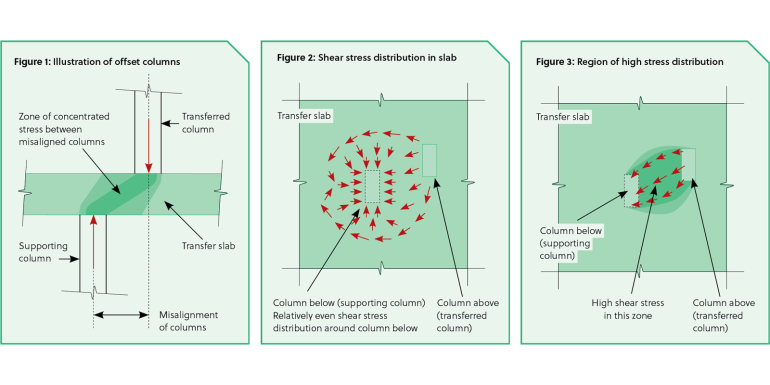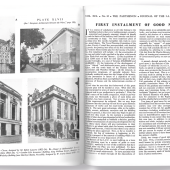CROSS UK Report 1301

This report relates to punching shear assessments of flat slabs used as transfer slabs to support transferred columns (ie columns above the transfer slab that are misaligned with the columns below). The reporter is concerned some design engineers erroneously use the principles of uniformly loaded slabs to assess punching shear.
Through peer review work, the reporter says their firm has observed transfer slabs analysed using a Finite Element Analysis (FEA) model (which provides reactions on the supporting columns) to obtain moment plots for determining the bending reinforcement. These reactions are put into spreadsheets that are only intended to quantify the shear reinforcement for a flat slab with a uniform load, amplified with beta factors. This underestimates the localised shear stress between non-aligned columns as it ignores the shear concentration between them.
The reporter explains that, for cases where a transfer slab supports a transferred column and there is close proximity between the transferred column and the supporting column, there is a highly stressed zone of concrete between the two columns (see Figures 1, 2 and 3).
Whether a local inclined strut calculation or a punching shear assessment of the transfer slab is required depends on the proximity of the columns. However, even for transferred columns spaced apart in the range normally applicable to punching shear, they add that the punching shear stresses can be significantly higher than the stresses obtained from a conventional assessment (intended for flat slabs with uniform loading and without transferred elements).
The reporter explains that, to allow for uneven distributions of shear stress around the support, design shear stress in a conventional punching shear assessment for a uniformly loaded slab takes into account the reaction around the column in question along with a magnification of the load. The issue with transfer slabs is that the load is concentrated by a transferred column and the magnification of the reaction using the method contained within the Eurocode is not appropriate for estimating the additional design shear stresses from the transferred columns above.
If an assessment has not been carried out correctly, there is an unacceptable risk that the zone between the columns is highly stressed, exceeding the requirements in the codes of practice (for example, Eurocode 2). In such instances, even taking into account reductions in safety factors for the bespoke nature of the building structure under consideration, there may be a need for remedial works.
This has an impact on the building owner and tenants of the building. It can be costly and disruptive to install. It can also potentially change the floor layout to accommodate the new structure.
The reporter believes the likely causes are a lack of understanding and code rules being misapplied to design conditions for which they were not intended. They are also concerned this may be an industry-wide issue so chose to submit a report to CROSS to encourage other engineers to undertake appropriate assessments for transfer slabs and not repeat the errors they have witnessed.
The reporter advocates that guidance on the design of shear assessment of transfer slabs be included in university courses. They also suggest in code sections related to shear assessments, clear advice is needed to show that assessments for uniformly loaded slabs are not appropriate for elements with concentrated loads, such as transfer slabs, which instead require assessment using first principles.

Comments
When circumstances beyond the ordinary are encountered it seems that some designers are more likely to resort to a FEA model in the belief that it will provide all the answers. The reporter is concerned that miscalculation may lead to remedial works being required. However, it is known that punching shear failures can be sudden with little or no warning. There might be evidence of precursors to failure in the form of cracks in the slab adjacent to the column in question, but these might not be obvious and their relevance might not be recognised. It is vital the design is fundamentally sound with no risk of punching shear failure.
While FEA may well be the best way to determine the shear distribution around the critical perimeter, the problem is with applying code rules, such as those in Eurocode 2, to situations for which they were not written. The assumptions used in the background to the code may not apply. As always, the designer must be sure that their calculations adequately represent the distribution of forces and stresses by using alternative methods to validate computer models. These can include approximate methods.
The Institution of Structural Engineers (IStructE) published guidance on this issue in Design of Transfer Slabs: “This guidance has been produced by a cross-industry group in response to a gap in advice in the application of standards in the design subject. In such circumstances engineers have adopted different methods. This guidance is aimed at ensuring that the design of new transfer slabs is consistent and robust, in accordance with current knowledge.”
A further quote from the guidance emphasises the safety-critical importance of good design: “Designing a transfer slab requires the engineer to have great confidence in their understanding of short- and long-term concrete behaviour, design against disproportionate collapse and the behaviour of concrete in shear.”
To subscribe to the CROSS UK newsletter (structural and fire safety concerns), visit cross-safety.org/uk/user/register






